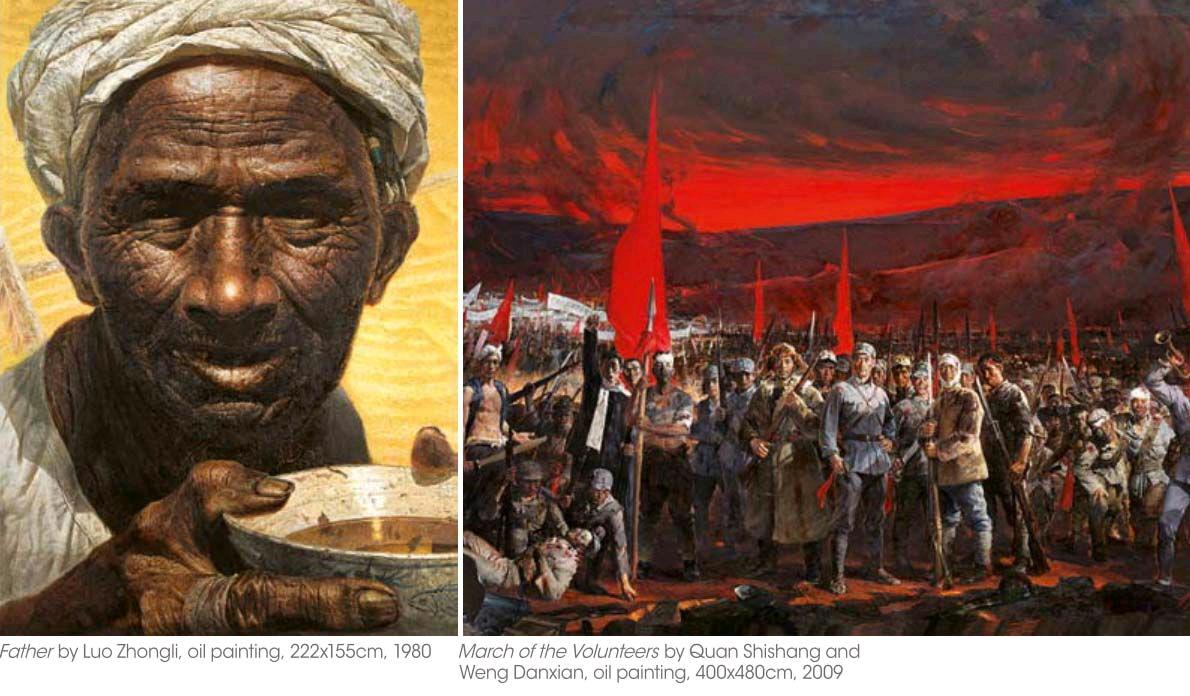Painting the Chinese Dream
by+De+Jia
For the very first time, an oil painting was placed in the square hall of the National Art Museum of China (NAMOC), a location usually reserved for opening ceremonies and posters promoting exhibitions. The oil painting, March of the Volun- teers by Quan Shishan and Weng Danxian, shares the same name as Chinas national anthem. Perhaps only a visual national anthem could properly embody the theme of Painting the Chinese Dream, an exhibition celebrating the 65th anniversary of the founding of the Peoples Republic of China. Covering every exhibition hall on the first floor of the museum, the campaign displayed 300 artistic works from the hands of Chinese masters since the turn of the 20th Century. It was divided into three parts: Renewal of the Nation, Prosperity for the Country and Happiness for the People.
Burning Opium at Humen Port led the way for Renewal of the Nation, which heavily featured dark yellow colors. This section also included three subcategories, Awakening & Fighting, Sunrise from the Orient and National Independence, focusing on the suffering of the Chinese nation in modern times and the process of liberation led by the Communist Party of China (CPC). The works depicted many important historical events such as the founding of the CPC, the Long March, War of Resistance against Japanese Aggression as well as national liberation and some critical figures includ- ing Sun Yat-sen and Mao Zedong. This part demonstrated that the Chinese Dream was born in the awakening of the Chinese nation and in a period when Chinese people were plagued with unrelenting misery.
Prosperity for the Country featured heavy bright red colors, recounting stories of Chinese pursuits for the Chinese Dream over the past 65 years since the founding of New China. The highlight was Founding Ceremony of the Peoples Republic of China by Tang Yongli, which was positioned in the center of the exhibition hall. Works in this area such as Tibetan Railway and The Spring of Science concentrated on Chinas achievements in fields of agriculture, indus- try, national defense, diplomacy, education and culture, especially after the countrys opening up and reform. Additionally, some works like A Morning of the Power Station by Yang Qiuren and Todays Beijing by Xu Xi illustrated the Chinese Dream from the perspective of ordinary Chinese people.
Stained with pink and green hues, Happiness for the People portrayed Chinese peoples living standards improving as well as aspirations for better livelihood and a harmonious society characterized by well-being. In this section, artistic creation appeared more diverse and from a wider range of perspectives. Works like In Front of Tiananmen Square by Sun Cixi and Green Power by Zhu Dequn featured active spirit and unique artistic designs. Exceeding expectations, the exhibition wrapped with two multimedia works. In Pan Gongkais Fusion, a video work, words from Hans Beltings books of art history dropped on a withered lotus like snowflakes. And in Shen Fans To Commemorate Huang Binhong (a Chinese art master), every ten seconds, a beam of light with sound flashed for the duration of the exhibition. “While promoting traditional Chinese culture, we also presented contemporary creations to inspire contemplation of future artistic trends,” remarked Zhang Qing, director of Planning and Research Department of NAMOC. “This also mirrored the connotations of the Chinese Dream of art.”
“This exhibition covered Chinese painting, oil painting, printmaking, sculp- ture, picture books, New Year painting and new media works, which composed a massive scroll displaying Chinese pursuits for national independence, prosperity and happiness,” notes Fan Dian, president of NAMOC. “The exhibition also reflected the characteristics of these times, effectively branding Chinas art development.”

